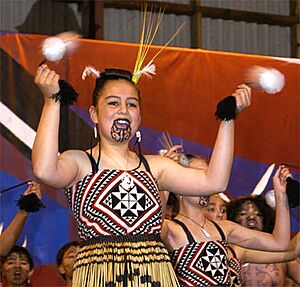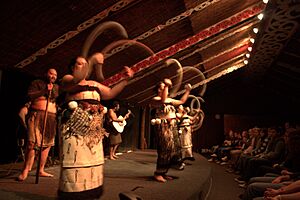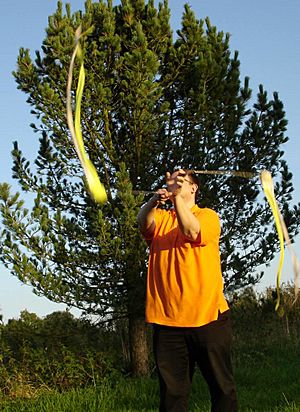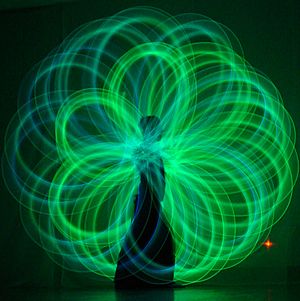Poi (performance art) facts for kids
Poi is a cool art form where you swing weights attached to ropes in cool patterns. It's also the name for the equipment you use to do it! Poi performers often dance or sing while they swing their poi. The poi themselves can be made from different things and have various handles, weights, and even special effects like fire!
Poi started with the Māori people in New Zealand, and they still practice it today. But now, people all over the world enjoy poi. This has made poi culture grow, changing the styles, tools, and even what the word "poi" means.
Contents
Poi in Māori Culture
In the Māori language, poi can mean the actual objects dancers use, the dance moves, or the music that goes with it. In Māori culture, women usually perform poi. Some old stories say men first used poi to make their wrists stronger for weapons like clubs. However, recent studies haven't found proof for this story.
Māori poi come in two main types:
- Short poi: Their strings are about the length from your fingertips to your wrist.
- Long poi: Their strings are about the length from your fingertips to your shoulder.
A poi performance often tells a story or includes singing. It's done with special poi routines and is often part of bigger shows called kapa haka, which include singing (waiata a ringa) and traditional dances (haka). The famous 1980s song "Poi E" even features poi!
How Traditional Poi Were Made
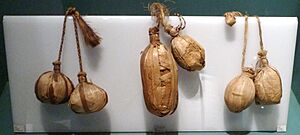
Long ago, poi were usually made from New Zealand flax (called harakeke) and a plant called raupō (which is like a cattail). Makers would prepare the flax to get the soft inner fibers, called muka. These fibers were twisted into two strands to make the taura (the cord) and the aho (the ties).
A big knot was tied at one end of the cord. The soft middle part of the raupō stem was shaped around this knot to form the ball. Wet strips of raupō stems were then wrapped around the ball and tied tightly with the cord. The other end of the cord was often decorated with a mukamuka, which is a tassel made from muka fibers. Sometimes, smaller tassels called poi piu were added to the bottom of the poi ball. How poi were made and designed varied a lot depending on the region, tribe, and even personal choice.
Another type of poi was called poi tāniko. These had an outer shell made from finely woven muka fibers, often with a pattern like a fishing net. Sometimes, yellow dyed strands were woven in to create a diamond pattern called Te Karu ō te Atua (the Eye of God).
In the late 1800s and early 1900s, many people in places like Rotorua started making raupō poi at home to sell to tourists. They even made tiny poi that people could wear as earrings or in buttonholes!
Today, traditional raupō poi are not used as much by modern performers. This is because the natural materials wear out quickly with lots of use. Also, flax and raupō are harder to find now because the wetlands where they grow have been changed or protected.
Most performance poi today are made from strong, easy-to-find modern materials. The inside of the poi ball is often made of foam or crumpled paper. The outside covering might be plastic or woven fabrics like tulle. The tassels are usually made of wool.
Modern Poi
Modern poi is popular all over the world, alongside traditional Māori poi.
Traditional Māori poi is usually performed by groups at cultural events, with singing and music. Modern poi, however, is often done by individuals, usually without singing and with less planned dance moves. The tools and styles used are much more varied. Many people first see poi as "fire spinning," but fire poi is just one exciting type of this art!
Modern poi takes ideas from other physical arts, like different kinds of dance and many object manipulation arts (like juggling). Poi is practiced globally and can often be seen at big festivals like Burning Man and the European Juggling Convention.
Unlike many physical arts, you usually don't go to a formal school to learn poi. Most spinners learn from each other or teach themselves using videos online. A strong sense of community and learning on your own are key parts of modern poi.
Practice Poi
Beginners often start with simple practice poi. These are usually made from soft materials like socks or stockings. They are weighted with soft things you can find at home, like bean bags, juggling balls, balloons filled with beans, or small toys. You can also make simple poi from tennis balls and pieces of rope.
More advanced practice poi can have special parts like swivels (for spinning tricks) or weighted handles (for throwing the poi). Some even use special "contact" balls that let the spinner do moves where the poi rolls on their body.
Performance Poi
Performers often use poi with bright, contrasting colors. This makes the poi look amazing and helps people see the patterns they create. Some performance poi also have long tails or streamers for an extra visual effect.
Glow Poi
Poi can look really cool in the dark when performers use poi that light up. These "glow poi" might have special materials that react to UV light, LED lights, or chemical glow sticks inside them. "Glowstringing," which is swinging glowsticks on shoelaces, is popular at festivals and raves. While poi focuses on moving the weighted end, glowstringing often focuses on moving the cord itself.
Meteor Poi
Meteor poi were inspired by both regular poi and a Chinese martial arts weapon called the meteor hammer. A meteor poi is often built like a regular poi, or you can even make one using poi parts. However, a meteor also has an extra short chain, rope, or bar in the middle. This means that many poi skills can be used with a meteor, plus some skills from staff, rope dart, and chain whip arts.
Fire Poi
Fire poi use special wicks made from kevlar or another material that resists flames. These wicks are at the weighted ends of the poi. The wicks are soaked in fuel, set on fire, and then spun to create a dramatic fiery show!
Health Benefits of Poi
A scientific study done by Kate Riegle van West at the University of Auckland showed that practicing poi for just one month can greatly improve your grip strength, balance, and ability to pay attention. She and others in different countries are now using poi to help people improve their well-being. They are also helping organizations start poi programs to promote health.
See also
 In Spanish: Poi (malabarismo) para niños
In Spanish: Poi (malabarismo) para niños


